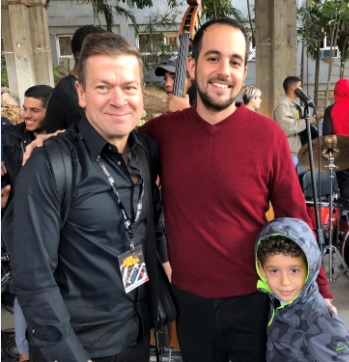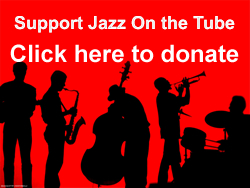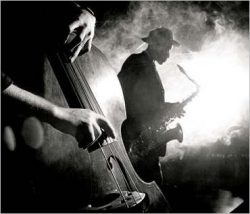Artist-Educators, Blog, Cuba, Cuban Jazz, Festivals, The Cuba-US connection, Video and audio
As many Jazz on the Tube subscribers know, Jazz on the Tube is taking an active role in providing support to the jazz community in Cuba.
One form this takes is providing Havana-based jazz educator Camilo Moreira with scores, videos, and other educational materials.
Last summer, we brought Camilo to New York City which included a day touring music and cultural sites in the Bronx with Bobby Sanabria.
How are Camilo’s kids doing? You tell me. Here they are with “Perdido.”
There’s good news and bad news here. The good news is the music itself.
This is a high school band (ENA) and these are mostly underclassmen, new to the band and I presume jazz itself.
The band has only been working together since October of 2017 and this was recorded in late January 2018.
The bad news is that, thanks to US politics, this group will not be performing in the Essentially Ellington competition at Jazz at Lincoln Center this spring, something many of us had been eagerly anticipating.
Here’s the band playing a Cuban classic “Son de Loma,” a composition by Miguel Matamoros that pays tribute to the island’s musical fertility…”Mom, I want to know where those singers are from. I find them very gallant.”
The next piece was a surprise.
The audience clamored for the Philharmonic Orchestra of ISA (Instituto Superior de Arte) to play an encore after a performance of a series of pieces by Ray Lerna of the Republic of the Congo at Havana’s Jazz Fest.
They’d run through all of Mr. Lerna’s pieces – so they played one by their beloved theory and composition teacher, our man in Havana Camilo Moreira!
Next, Camilo’s nephew, age 5, tries his hands at the tambores (drums.)
Surprisingly, drums are hard for the young to get their hands on in Cuba (as are trumpets in New Orleans), so I believe Camilo when he says this was his nephew’s first try at them. Not bad.
A parting picture…
Swedish trumpeter and composer Stefan Johnsson, Camilo and his nephew who is clearly ready for show business.
Johnsson collaborated with Camilo and the ENA Jazz Band as part of Havana’s Jazz Fest 2018. (Note: Sweden is one of 188 counties NOT participating in the US economic blockade against Cuba.)

People who buy the Jazz on the Tube Insiders Guide to Cuba are helping support these efforts and more. All profits go to the cause, the cause being helping jazz musicians in Cuba develop their art and pass it on to the next generation.
Great news!
You can now watch this video – and all Spanish language videos – with English subtitles. It’s free!
Click here for instructions on how to turn on English subtitles.
– Ken McCarthy
Jazz on the Tube
Go to Cuba with Jazz on the Tube as your guide:
Click here for details
Afro-Cuban culture, Blog, Cuba, Cuban Jazz, The Cuba-US connection, Travel to Cuba, Video and audio
The album that resulted from Amram’s
last trip to Cuba over 40 years ago
Interview
Download the mp3 here
40 years later David Amram returns to Cuba….
In 1977, the Carter administration gave permission to a group of US jazz musicians to travel to Cuba the first such trip in the fifteen years after the Revolution there.
Dizzy Gillespie, Stan Getz, Earl “Fatha” Hines, Ray Mantilla, and David Amram landed in Havana for a 36-hour musical whirlwind.
Now, forty plus years later, Amram is making a long-awaited return trip, this time for a week to perform at the Havana Jazz Festival – an invitation facilitated by Jazz on the Tube.
– Ken McCarthy
Jazz on the Tube
Afro-Cuban culture, Blog, Cuba, Cuban Jazz, Latin Jazz, Puerto Rico, The Cuba-US connection, Video
Cándido de Guerra Camero was born April 21, 1921 in Havana, Cuba, which makes him 96 and half years old (and one day) on the day of this recording.
Cándido is the most recorded conga player in the history of jazz having appeared on well over 1,000 albums.
Perhaps even more remarkable – and this is something many people have trouble wrapping their minds around – he is the first person to perform with multiple congas at the same time.
It may seem like an “obvious” idea, but as for all obvious ideas, someone had to go first and that somebody was Cándido de Guerra Camero.
Here’s the story straight from the Maestro’s mouth…
When Cándido first visited the US in 1946, in addition to being a percussionist, he also was a master on the bass, guitar and tres.
The rabbit hole goes even deeper…
Everyone is aware that Afro-Caribbean music was created from elements of African music. What fewer people are aware of is that the creative contributions have flowed both ways.
The practice of a single drummer performing with three or more drums first appeared in Senegal in the 1970s.
According to the liner notes of “Bougarabou: Solo Drumming of Casamance” (Village Pulse Records) the Jola of Senegal played just one drum, adding two later, then finally graduating to three or four in the late ’70s.
What stimulated this sudden innovation in an already well developed musical tradition?
Believe it or not, the evidence points to the influx and popularity of salsa records in the region.
Yes, salsa.
So we come full circle…From Africa to the Caribbean to New York City and back to Africa.
And who was on those records that changed the way the Jola of Senegal approached the drums? Almost certainly Puertorriquenos
Hanging around at home, Bacary Olé Diedhiou, Senegalese master of Bougarabou, gives an informal demo.
OK, we’ve informed you and hopefully entertained you.
Over forty musicians donated their time and talents to create the material we’ve shared with you in this series.
Over $10,000 in donated video production and post-production and web services were donated to bring you these highlights.
If you haven’t given yet, now’s the time. Thanks.
– Ken McCarthy
Jazz on the Tube
P.S. Our unique programming is made possible by help from people like you. Learn how you can contribute to our efforts here: Support Jazz on the Tube
Thanks.
Afro-Cuban culture, Blog, Cuba, Cuban Jazz, Latin Jazz, Video and audio
The deeper you dive into Cuban music, the more amazing it reveals itself to be.
Sometimes I have to ask myself is Cuba a country – or an alternate universe?
How can such a small country – with less people than Ohio – generate so much musical accomplishment?
Notice: I don’t day “talent.”
Talent is a dime a dozen. Realization of talent is the thing that matters.
It takes dedication and relentless study – and a higher moral purpose – to turn raw musical talent into accomplishment the way the Cuban people have.
Here’s an example of all the various threads of Cuban music brought together on one stage: reverence for classical music, immersion in Afro-Cuban rhythms, affection for popular genres, and hip-as-hell jazz sensibilities.
Who is this flute playing musical visionary dressed in white?
Meet: Orlando Valle, aka Maraca. Enjoy and Viva Cuba!
How about another one? The small unit works out on “Manteca”
– Ken McCarthy
Jazz on the Tube
P.S. Our unique programming is made possible by help from people like you. Learn how you can contribute to our efforts here: Support Jazz on the Tube
Thanks.
Afro-Cuban culture, Blog, Cuba, Cuban Jazz, Video and audio
The members of the group Los Terry talk about two things:
1. The musical instrument the chekere
2. The training that master musicians in Cuba receive which is unique in the world
Tell me where else on the planet musicians master classical music, local popular music, indigenous music, religious music and jazz.
There’s a reason Cubans have had such a out-sized impact on world music: Their training, discipline and versatility are second to none.
The conversation is a bit slow moving at times and a lot of it is in Spanish, but stick with it. It will give you an unparalleled insight into what goes into making a Cuban musician.
In the conversation:
Eladio Terry, the patriarch of the family, known to many as Don Pancho
Yosvany Terry
Yunior Terry
Some musical reference from the interview:
Yosvany Terry & The Afro Caribbean Quintet
More about Los Terry and Don Pancho (Eladio Terry)
Los Terry are a family of musicians from the Camaguey province of Cuba. Their unique blend of musical styles includes elements of folklore, classic charanga and modern jazz, creating a bridge across generations.
Eladio Terry, the patriarch of the family, known to many as Don Pancho, grew up surrounded by the music of the Afro-Cuban religions and learned the traditional drumming and vocal styles that date back centuries. Eladio followed the path of the apprentice drummer as he learned the prayers, songs and rhythms that accompany the religious ceremonies- watching, listening and playing for hours. Like many Cuban musicians, he also learned to play popular music styles, incorporating his knowledge of African traditions into the secular dance music of the day.
Eladio Terry’s influence in Cuban music began with the legendary charanga group Maravillas de Florida, from the town of Florida in Camaguey. He utilized the chekere with the traditional charanga format of violins, bass timbales, flute, piano, and guïro, adding an instrument widely used in the syncretized African religions that have survived and flourished in Cuba.
The chekere is an instrument made out of a gourd strung with beads that requires a sophisticated physical dexterity to produce rhythms and harmonic timbres. Eladio Terry and his sons handle the chekere like veteran basketball players taunting their opponents as they effortlessly coax rhythms and tones out of these hollow gourds.
In the early 1960s Eladio went to the newly formed Conservatory of Music in Havana. There he met fellow music students from Mali who became legendary figures in contemporary African music when they formed Maravillas du Mali and wrote the theme song for Radio Mali in a Cuban charanga style. Eladio recalls that they had assimilated much of the Cuban rhythms but could not understand the role of the bass. He claims credit for teaching them the subtleties of the tumbao or “swing” of the bass that can’t easily be notated or understood without grasping the fundamental structure of Cuban music.
Traveling with the Maravillas de Florida in the 1970s Eladio visited many African countries as well as Eastern Europe and the Middle East. As director, violinist and arranger he was able to incorporate many of the musical influences of his travels into his music. The recordings of the Maravillas from this period are spiced with African-based rhythms, harmonies and timbres that he introduced, giving the charanga a very Afro-Cuban feel.
Yosvany recalls that when the Maravillas played Son Wambari at outdoor dances people in the audience were seized by trances when they heard the Yoruba chants and the familiar incantations calling out to Elegua.When the Maravillas toured Africa they found that many people understood the meaning of the words to the Yoruba and Congo chants that they sang which are part of religious rituals in Cuba.
Cuba’s nationwide musical education program has had a profound effect on the development of countless talented musicians. Cuba has always had a wealth of musical talent but few of the youth from poor families had the resources to receive the formal training and practice time that would allow them to master forms of music other than those with which they had direct experience. Eladio Terry’s sons, Yosvany, Yoel and Yunior have all passed through intense musical conservatory training as well as paying their dues in popular music groups and have sharpened their skills playing improvisational jazz.
– Source: Excerpted from the excellent resource AfroCubaWeb.com
– Ken McCarthy
Jazz on the Tube
P.S. Our unique programming is made possible by help from people like you. Learn how you can contribute to our efforts here: Support Jazz on the Tube
Thanks.
Afro-Cuban culture, Blog, Cuba, Cuban Jazz, Latin Jazz, Puerto Rico, The Cuba-US connection, Video and audio
This montage of the October 23 Benefit for Puerto Rico at Poisson Rouge (the old Village Gate) was created and contributed by the very talented Garbriel Moreno of Tableaux Multimedia.
Select video of the actual concert will be coming soon. Watch for it here.
Meanwhile…
Jazz and Latin music have been brothers for as long as jazz has been an art form
Jelly Roll Morton laid it out:
“If you can’t manage to put tinges of Spanish in your tunes, you will never be able to get the right seasoning, I call it, for jazz.”
In 1930, Don Azpiazu knocked down the doors of American popular music with The Peanut Vendor.
Machito and his musical hermano (and real life brother-in-law) Mario Bauzá kicked it into high gear with one of the greatest big bands ever to rock a jazz stage.
Then in 1947, thanks to an introduction by Bauzá, bepop pioneer Dizzy Gillespie teamed up with Chano Pozo to create a model for collaborations between Latin and Jazz musicians that has been going strong ever since.
Started by the Mario Bauzá’s rhythm section and jazzman Sonny Fortune, Monday night at the Gate was THE place to go with crowds lining up around the block to get in.
On Monday October 23, 2017, in support of the people of Puerto Rico, many of the giants who were part of this legendary time came back for a once-in-a-lifetime, never-to-be-repeated reunion with Bobby Sanabria‘s big band Multiverse.
Over time, we will be releasing video of this historic event.
Meanwhile, this is what it’s all about…
No sightseers please. We need givers right now. Please read how you can help.
– Ken McCarthy
Jazz on the Tube



